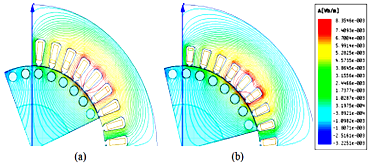Optimal design of stator slot with semi-closed type to maximize magnetic flux connection and reduce iron leakage in high-speed spindle drives
Main Article Content
Abstract
A novel approach was devised to optimize the stator slot semi-closed type in order improve the magnetic flux connection and minimize iron leakage in high-speed spindle drives. The concept was executed through a combination of response surface approach including the technique of finite element analysis. The primary objective of this investigation would be to provide an engineering approach which improves the functionality of stator criteria, including the stator slot geometry, coil turn per slot, and wire size. The purpose is to achieve higher flux connection and minimize iron leakage. This study presents an enhanced analytical approach that incorporates the analysis of stator flux connection, finite element calculation of flux connection, and iron leakage analysis of stator variables. The results are analyzed through the utilization of finite element computation, and their accuracy is verified through experimental measurements. The findings suggest the ideal design yields increased magnetic flux connection and reduced iron leakage in comparison to the industrial layout. The precision provided by the suggested model is confirmed through the comparison of the simulation and experimental information. In general, the percentage of errors is estimated to be around 7%.
Downloads
Article Details

This work is licensed under a Creative Commons Attribution-NonCommercial 4.0 International License.
References
[2] O. Payza, Y. Demir, and M. Aydin, “Investigation of losses for a concentrated winding high-speed permanent magnet-assisted synchronous reluctance motor for washing machine application,” IEEE Transactions on Magnetics, vol. 54, no. 11, Nov. 2018, doi: 10.1109/TMAG.2018.2848881.
[3] K. Kawanishi, K. Matsuo, T. Mizuno, K. Yamada, T. Okitsu, and K. Matsuse, “Development and Performance of High-Speed SPM Synchronous Machine,” 2018 International Power Electronics Conference, IPEC-Niigata - ECCE Asia 2018, pp. 169–176, Oct. 2018, doi: 10.23919/IPEC.2018.8507781.
[4] K. Bataineh and A. Al Rabee, “Design Optimization of Energy Efficient Residential Buildings in Mediterranean Region,” Journal of Sustainable Development of Energy, Water and Environment Systems, vol. 10, no. 2, Jun. 2022, doi: 10.13044/J.SDEWES.D9.0385.
[5] M. Srbinovska and M. Cundeva-Blajer, “Optimization Methods for Energy Consumption Estimation in Wireless Sensor Networks,” [Journal of Sustainable Development of Energy, Water and Environment Systems], vol. [7], no. [2], p. [261]-[274], Jun. 2019, doi: 10.13044/J.SDEWES.D6.0244.
[6] W. Purwanto, H. Maksum, T. Sugiarto, M. Nasir, and F. Rizal, “The Effect of Stator Winding Parameter Design to The Magnetic Flux Characteristics in High-Speed Motor Applications,” Journal of Theoretical and Applied Information Technology, vol. 30, no. 12, 2019.
[7] W. Purwanto, H. Maksum, T. Sugiarto, Risfendra, A. Baharudin, and Marno, “Optimal design of stator slot geometry for high-speed spindle induction motor applications,” 2019 International Conference on Information and Communications Technology, ICOIACT 2019, pp. 811–816, Jul. 2019, doi: 10.1109/ICOIACT46704.2019.8938493.
[8] M. Aishwarya and R. M. Brisilla, “Design of Energy-Efficient Induction motor using ANSYS software,” Results in Engineering, vol. 16, p. 100616, Dec. 2022, doi: 10.1016/J.RINENG.2022.100616.
[9] S. Chakrabarty and R. Kanagaraj, “Design, Simulation, and Analysis of Switched Reluctance Motor for High-Speed Applications,” 2021 National Power Electronics Conference, NPEC 2021, 2021, doi: 10.1109/NPEC52100.2021.9672508.
[10] N. Rossi et al., “Design and thermal assessment of a high performance electric motor for racing applications,” Proceedings - 2021 IEEE Workshop on Electrical Machines Design, Control and Diagnosis, WEMDCD 2021, pp. 52–57, Apr. 2021, doi: 10.1109/WEMDCD51469.2021.9425681.
[11] F. Xu et al., “Comparison of 2-pole Slotted High-speed Motors with Toroidal and Tooth-coil Windings,” Proceedings of 2022 IEEE 5th International Electrical and Energy Conference, CIEEC 2022, pp. 3410–3415, 2022, doi: 10.1109/CIEEC54735.2022.9845996.
[12] W. Purwanto, T. Sugiarto, H. Maksum, D. S. Putra, and E. Alwi, “Comparison of Three Topologies Rotor to Improve Efficiency and Torque for High-Speed Spindle Motor Applications,” Proceedings of ICAITI 2018 - 1st International Conference on Applied Information Technology and Innovation: Toward A New Paradigm for the Design of Assistive Technology in Smart Home Care, pp. 176–181, Jul. 2018, doi: 10.1109/ICAITI.2018.8686718.
[13] M. Appadurai, E. Fantin Irudaya Raj, and K. Venkadeshwaran, “Finite element design and thermal analysis of an induction motor used for a hydraulic pumping system,” Materials Today: Proceedings, vol. 45, pp. 7100–7106, Jan. 2021, doi: 10.1016/J.MATPR.2021.01.944.
[14] J. Li et al., “Research on the Effect of Spindle Speed on the Softening and Hardening Characteristics of the Axial Operating Stiffness of Machine Tool Spindle,” Lubricants 2022, Vol. 10, Page 132, vol. 10, no. 7, p. 132, Jun. 2022, doi: 10.3390/LUBRICANTS10070132.
[15] L. A. Pereira, M. Perin, L. F. A. Pereira, J. R. Ruthes, F. L. M. de Sousa, and E. C. P. de Oliveira, “Performance estimation of three-phase induction motors from no-load startup test without speed acquisition,” ISA Transactions, vol. 96, pp. 376–389, Jan. 2020, doi: 10.1016/J.ISATRA.2019.05.028.
[16] F. Xu et al., “Influence of Slot Number on Electromagnetic Performance of 2-pole High-Speed Permanent Magnet Motors with Toroidal Windings,” 2020 15th International Conference on Ecological Vehicles and Renewable Energies, EVER 2020, Sep. 2020, doi: 10.1109/EVER48776.2020.9242986.

